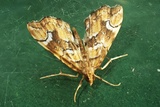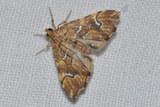Musotima nitidalis (Walker, [1866]) Species
Last modified: Nov. 20, 2025, 8:04 p.m.
First discovered in Belgium in 2023 at WV.
Details
- Classification
- Family: Crambidae > Subfamily: Musotiminae > Genus: Musotima > Species: Musotima nitidalis
- Vernacular names
- Varenhobbit (NL), Golden-brown Fern Moth (EN)
- Status
-
Naturalised
The species is native to Australia and New Zealand and is suspected to have originally been imported with tree ferns as a result of the horticultural trade.
For your information, to the best of our knowledge, the first 10 Belgian observations are listed here:
1) 1 ex. on 10.x.2023 at De Panne (WV), leg. W. Laforce.
2) 1 ex. on 20.x.2023 at Wenduine (WV), leg. S. Stevens.
3) 2 ex. 10.v.2024 at Sint-Andries near Brugge (WV), leg. R. Vannieuwenhuyze & P. Vandousselaere.
4) 1 ex. 31.viii.2024 at Wachtebeke (OV), leg. Nachtvlinderwerkgroep Waasland et al.
5) 1 ex. on 02.ix.2024 at Destelbergen (OV), leg. P. Vantieghem.
6) 1 ex. on 05.ix.2024 at Assenede (OV), leg. W. De Smet & M. Baete.
7) 1 ex. on 06.ix.2024 at Ieper (WV), leg. M. Willems.
8) 1 ex. on 14.ix.2024 indoors at Maldegem (OV), leg. I. Deroo.
9) 1 ex. on 20.ix.2024 at De Haan (OV), leg. H. Eggermont-Lens.
10) 1 ex. on 21.ix.2024 at Kalmthout (AN), leg. G. Vermeersch.
Distribution
Flight periods
Belgian data are from mid-April to mid-November.
Observed on
The larvae feed on various ferns.


